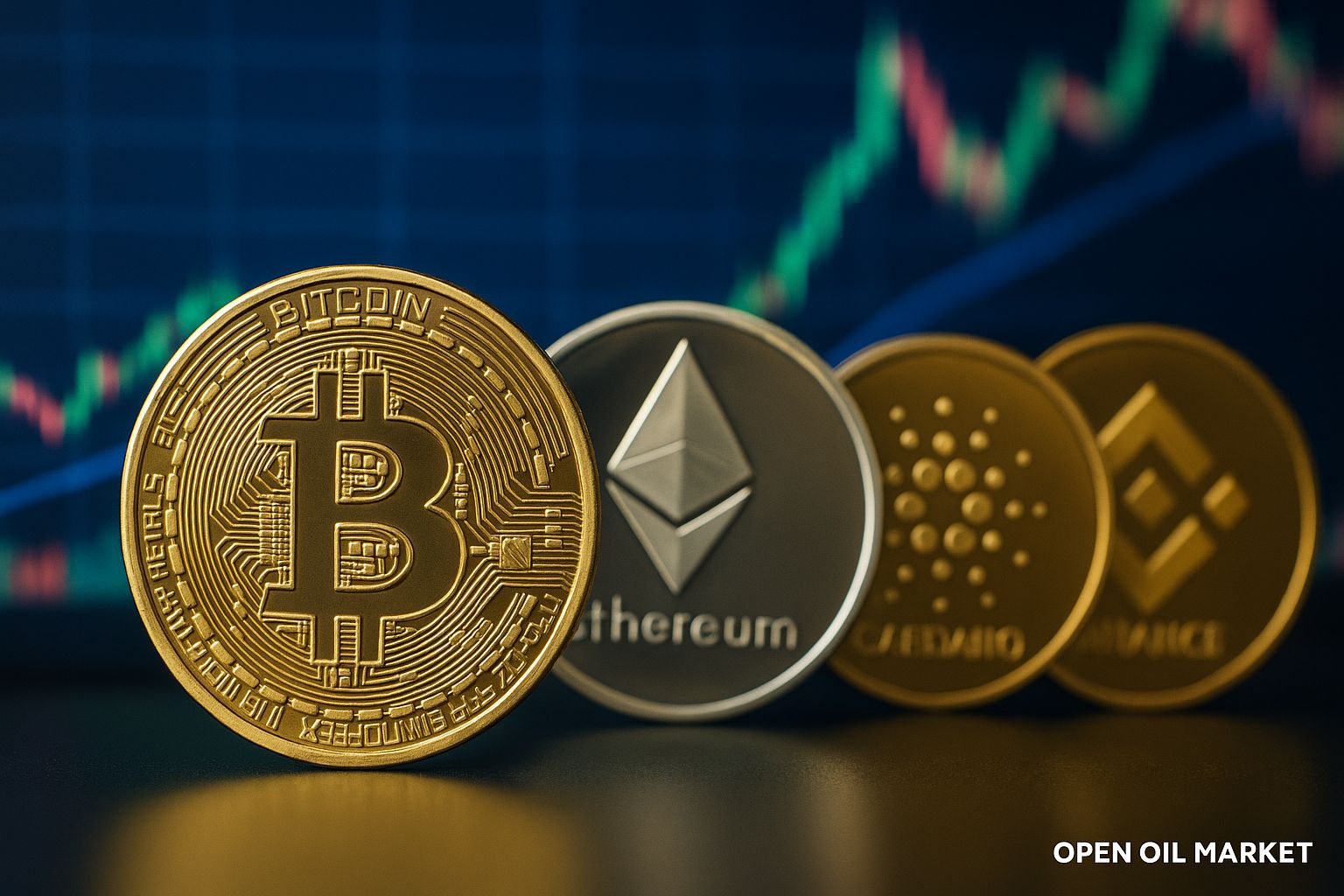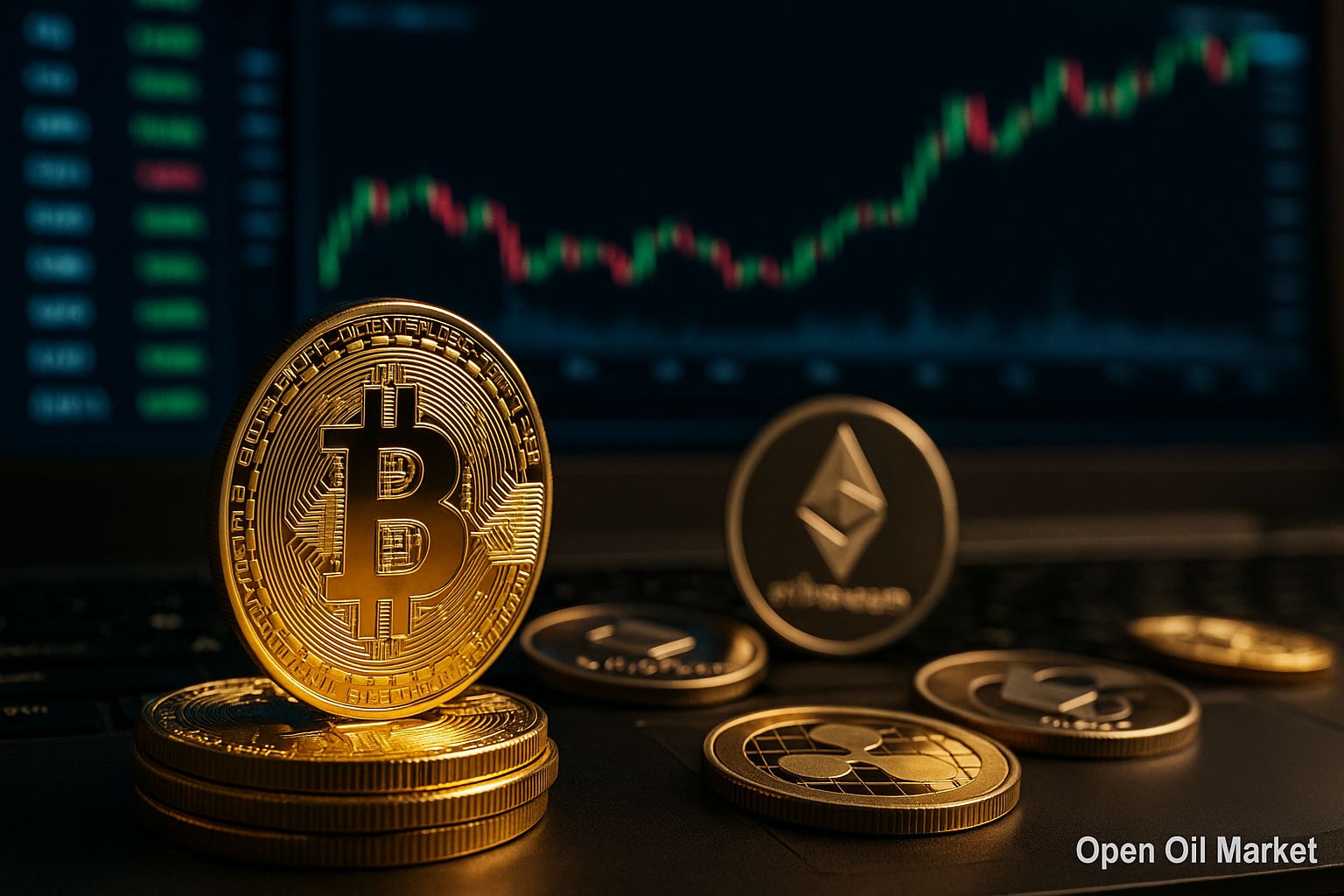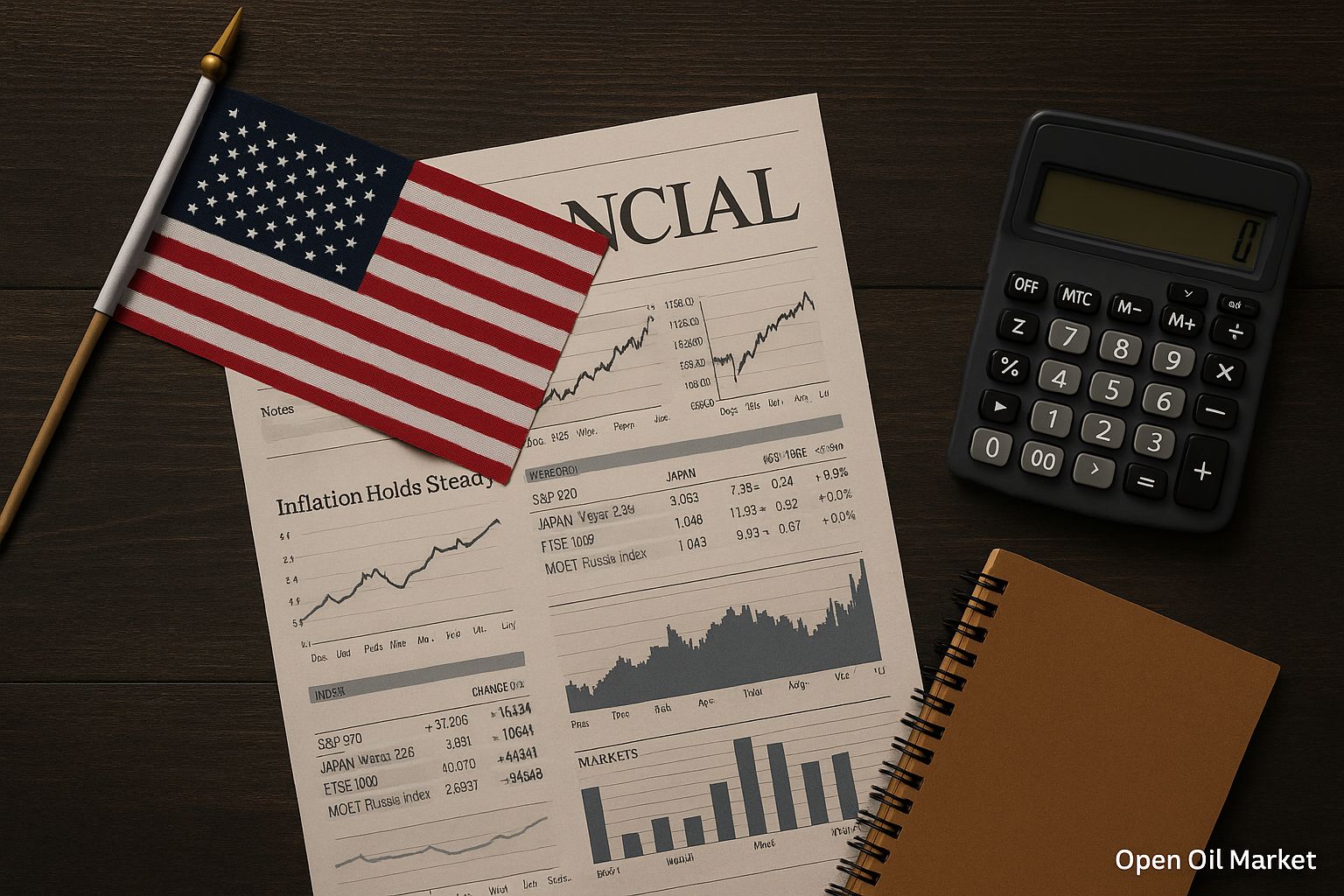
Current Cryptocurrency News — Friday, August 22, 2025: Bitcoin Holds at Record Highs, Ethereum Near Historic Peaks, Altcoins Showing Growth, and Investor Attention Focused on Fed Chair's Speech in Jackson Hole and New Regulatory Initiatives Worldwide. Analysis for Investors in the CIS.
The global cryptocurrency market maintains the positions acquired during the recent rally. Bitcoin, after a sharp rise, is consolidating at historical highs, instilling optimism among investors despite a minor correction. Leading altcoins also retain upward momentum, although market volatility has increased somewhat. Against this backdrop, regulatory developments are noteworthy: decisions expected in various countries over the coming days could significantly impact the industry. Below, we will take a detailed look at the current situation — from Bitcoin's movements and key altcoins to institutional interest and regulators' actions worldwide.
Bitcoin: Consolidation After Record Growth
Recently, Bitcoin (BTC) surpassed its historical maximum, exceeding $124,000. Now, after a decline of approximately 7-8% from its peak, the largest cryptocurrency is trading around $115,000. This drop is seen as a natural correction following the rapid rally of previous weeks. Several investors have locked in profits at peak levels, triggering the correction; however, the overall market sentiment remains positive. Even with the correction, BTC is now nearly double its price at the beginning of the year, with a market capitalization estimated at about $2.3 trillion (approximately 58% of the total cryptocurrency market capitalization).
Experts note that the current slowdown is a healthy "breather" before a potential new upswing. The market was slightly overheated after the rapid rally, and the short-term correction has helped relieve excess tension: overbought positions were liquidated, and the level of leverage among traders decreased. From a technical standpoint, an important support level for Bitcoin is around $114,000 — holding above this level signals the preservation of the upward trend. The resistance zone is near $120,000: a confident breakout above this mark will pave the way for new record highs.
The factors that fueled the BTC rally remain relevant. Investors expect a forthcoming easing of monetary policy in the U.S., while institutional players continue to increase their investments via exchange-traded funds (ETFs), and regulators are increasingly sending positive signals to the crypto sector. However, macroeconomic risks persist: an unexpected surge in inflation or stern statements from the Federal Reserve could temporarily cool the market. Indeed, this week, a strong comment from one of the Fed's representatives briefly pushed BTC's price below $113,000, yet overall buying demand quickly restored prices.
However, Bitcoin demonstrates resilience: long-term holders are not rushing to sell, considering BTC as "digital gold." Major corporations and funds are continuing to accumulate the asset — well-known companies collectively added several thousand BTC to their balances during the recent decline. This influx of capital from "big players" supports the market and reinforces confidence that the bullish trend is far from over.
Ethereum at Multi-Month Highs
The second-largest crypto asset, Ethereum (ETH), also shows strong upward movement. Earlier this week, the price of Ether exceeded $4,600 — the highest since 2022, closely approaching its all-time high ($4,867). After a minor pullback, Ethereum is trading around $4,200, remaining about 30% higher than a month ago. The market capitalization of ETH exceeds $500 billion (approximately 13% of the total cryptocurrency market capitalization).
Ethereum's growth is largely attributed to institutional demand and fundamental factors. In early August, investors actively poured funds into Ethereum-related products — inflows into ETH-based funds and ETFs reached record levels, outpacing similar Bitcoin funds. On August 15 alone, U.S. Ether ETFs attracted over $700 million, while Bitcoin ETFs saw approximately $80 million in inflows on the same day. Such a disparity indicates the strong confidence major players have in Ethereum's long-term prospects.
Among the reasons for optimism surrounding ETH are the expectations surrounding the launch of the first U.S. spot ETF for Ether. If regulators approve this product, access to Ethereum will be available to an even broader range of investors, potentially sparking a new price growth phase. Furthermore, the Ethereum ecosystem continues to evolve: the network is implementing various upgrades and scaling solutions, maintaining its position as the key platform for thousands of decentralized applications (DeFi, NFTs, and more).
Altcoin Market: Growth and Leaders
A wide array of other cryptocurrencies in the top ten also show positive dynamics. Following Bitcoin's rise, investor interest has shifted towards many altcoins, and several of them have shown notable increases (although volatility in this segment has risen). In particular:
- XRP (Ripple) - rose to ~$3.1, updating a multi-year high. The asset gained support due to favorable legal developments (Ripple's legal victory over the SEC) and expectations for an XRP-based ETF launch.
- Binance Coin (BNB) - reached a new record around $850. The Binance exchange token strengthened amid significant trading volume growth on the platform and the expansion of the BNB Chain ecosystem.
- Solana (SOL) - trading around $170–180. SOL remains one of the growth leaders due to its high transaction speed and the development of DeFi/NFT projects within its network.
- Cardano (ADA) - holding around $0.80. While ADA does not show sharp leaps, the Cardano network is actively developing in 2025 — new smart contracts and decentralized applications are being launched, which continues to foster community and investor interest.
- Dogecoin (DOGE) - around $0.22. The popular "meme coin" remains in the top ten by market capitalization: the price has increased due to community activity and celebrity mentions, though it exhibits high volatility.
- TRON (TRX) - recently entered the top ten, trading around $0.35. The TRON network is appreciating in value due to increased transaction activity and the popularity of stablecoins issued in this ecosystem.
Overall, the dynamics of altcoins remain uneven. Some leading coins (such as those listed above) hold their positions following the impressive rally of the first half of the year — their current prices reflect investors' faith in the technical potential of these projects. Conversely, several other altcoins are experiencing moderate corrections from recent local peaks (for example, Cardano and Dogecoin have slightly retreated from their highs). Nevertheless, overall interest in alternative cryptocurrencies remains strong, particularly those backed by active ecosystems or anticipated ETF launches. Investors continue to diversify portfolios, allocating capital between Bitcoin and promising altcoins.
Record Institutional Investor Interest
One of the key trends in 2025 has been the rapid increase in the share of institutional capital in the cryptocurrency market. Major banks, investment funds, and corporations are actively increasing their positions in digital assets, which is reflected in record inflows into crypto funds and ETFs throughout the year.
Concurrently, more new custodial services, trading platforms, and analytical tools for professionals are emerging — their development facilitates the entry of traditional financial players into the crypto industry. Experts compare this current stage to the early 2010s in the gold market when funds and central banks began to accumulate the precious metal, transforming it from an alternative asset into a mainstream market component. A similar process is observed with Bitcoin: more and more institutions are perceiving BTC as a strategic reserve asset and long-term investment.
Recently, following a powerful price rally, indications of short-term profit-taking have emerged among major players. In mid-August, cryptocurrency ETFs recorded significant outflows: for instance, on August 19, investors withdrew nearly $950 million from American spot Bitcoin and Ethereum ETFs in a single day. This marked the third consecutive day of negative flows, reflecting a temporary cooling after a week of capital inflows. Most of these sales were attributed to closing "long" positions in BTC and ETH, which coincided with a wave of liquidations in the futures market.
Nonetheless, the overall institutional trend remains upward. Major players continue to buy crypto assets at each pullback, and the total volume of institutional investments this year is already nearing record levels. Such sustained involvement of significant capital creates a solid foundation for the market and strengthens confidence that the bullish cycle is far from over.
Regulation in the U.S. and Europe: New Rules Approaching
Regulatory news is increasingly influencing the sentiments of the cryptocurrency market. In the U.S., decisions are on the horizon that could define the "rules of the game" for years to come. In July, the House of Representatives approved the first comprehensive legislation on digital assets — the Digital Asset Market Clarity Act of 2025 (the so-called CLARITY Act). This document aims to create a clear regulatory framework for cryptocurrency transactions and exchange activities, dividing oversight between the Securities and Exchange Commission (SEC) and the Commodity Futures Trading Commission (CFTC).
Now attention has shifted to the Senate, where on August 22, a relevant committee is reviewing its version of the cryptocurrency regulatory bill. Senators are expected to consider provisions of the CLARITY Act and strive for a compromise approach. The industry is pinning high hopes on these initiatives: the adoption of new laws could eliminate legal uncertainty, stimulate capital inflows into the sector, and enable the launch of new products (such as ETFs for individual altcoins). However, there is caution until final approval — investors are keenly observing debates, aware that any amendments or delays could impact the market.
Concurrently, U.S. regulators continue to send signals to the market. Recently, the Department of the Treasury officially announced that it does not plan to include cryptocurrencies in government reserves, limiting its management to previously confiscated digital assets. This news tempered the boldest expectations regarding direct government involvement in the crypto market. At the same time, the Department of Labor previously allowed digital assets (in moderate amounts) in certain 401(k) retirement plans, effectively recognizing cryptocurrencies as a legitimate investment class for long-term savings.
Additionally, the SEC's new leadership demonstrates a more open stance toward the industry. Chairman Paul Atkins stated that only a small fraction of cryptocurrencies should be considered securities, and the agency is preparing clear criteria to integrate digital assets into traditional markets. The SEC intends to cooperate with companies wishing to issue tokenized shares and funds and has already rolled back several high-profile lawsuits against major crypto exchanges initiated under previous leadership. These steps mark a radical shift toward more flexible policy and represent a significant victory for an industry long seeking clear rules.
In Europe, the implementation of a unified cryptocurrency regulation continues. The European Union has activated the Markets in Crypto-Assets (MiCA) regulation, which systematically establishes common requirements for exchanges, wallets, token issuers, and other market participants throughout 2024–2025. In recent months, several large crypto companies have received licenses to operate under the new rules, creating more predictable conditions for crypto businesses and strengthening the EU's position as one of the leaders in cryptocurrency market regulation.
Global Initiatives: Asia, Latin America, and Other Regions
Regulatory and strategic measures are being undertaken not only in the West but also worldwide. In Asia, special attention is being drawn to China, which, despite imposing strict bans on cryptocurrencies in mainland provinces, bets on Hong Kong. According to media reports, the Chinese authorities plan to launch the first stablecoin pegged to the yuan through Hong Kong — a special administrative region with a more liberal financial regime. Local regulators have already prepared the legislative framework: as of August 1, 2025, new rules for licensing stablecoin issuers have come into force.
The Hong Kong Monetary Authority (HKMA) announced that the issuance of the first stablecoin licenses will not commence until at least 2026, and their number will be strictly limited. Nonetheless, major Chinese companies are not wasting time: technology giant JD.com and Ant Group's fintech division (Alibaba) have already announced plans to obtain such licenses and issue their own stablecoins. It is anticipated that the new tokens could be pegged to both the Hong Kong dollar (for example, the "JD Coin" project is being discussed) and other currencies. Beijing is effectively responding to the global trend: while the U.S. promotes dollar-pegged stablecoins through private companies, China is preparing to pave the way for the international promotion of the digital yuan, which in the long run should reduce the region's dependence on the dollar.
In Latin America, Brazil's initiative has been key. On August 20, public hearings were held in the Brazilian parliament regarding a bill to establish a national Bitcoin reserve. It is proposed to gradually raise the proportion of Bitcoin to 5% within the country's gold and currency reserves. If this idea receives support, Brazil will become one of the first major economies to officially include cryptocurrency in its sovereign reserves — just a couple of years ago, such a move seemed almost unthinkable. Experts note that such a decision will enhance Bitcoin's legitimacy and may encourage other nations to consider BTC as a reserve asset. The example of small El Salvador, which made BTC a legal tender, is beginning to inspire larger countries in the region.
Southeast Asia is discussing similar approaches. Indonesian authorities announced they are studying the possibility of adding Bitcoin to national reserves and developing mining based on renewable energy sources. For this resource-rich country, it could be a double benefit: diversification of reserves and attracting investments in "green" mining. Meanwhile, Thailand is integrating cryptocurrencies into its tourism sector: as of August 21, the country launched a pilot project called TouristDigiPay, allowing foreign tourists to freely exchange cryptocurrencies for Thai baht under regulator supervision. This initiative aims to bridge the crypto economy with the tourism industry while maintaining strict financial oversight.
In the Middle East and other regions, the competition for crypto hub status continues. Jurisdictions such as the UAE and Singapore are refining their regulations to attract blockchain companies. The global trend is evident: governments are increasingly integrating cryptocurrencies into the existing financial system through clear rules. This reduces legal risks for investors and confirms that the crypto industry has firmly established its place in the global financial system.
Russia and the CIS: The Course Towards Control and the Digital Ruble
In Russia, regulators continue to tighten control over cryptocurrencies while simultaneously promoting state initiatives. Banks have recently been allowed to offer qualified investors instruments linked to the prices of crypto assets (derivatives and tokenized securities). There is a discussion about creating a special exchange platform accessible only to professional market participants.
For ordinary users, however, conditions are becoming stricter. Adopted amendments allow banks to block accounts in the case of suspicious P2P transactions with cryptocurrencies, and changes in legislation regarding payment systems have broadened the criteria for "high-risk" transactions and increased liability for money laundering through digital assets.
At the same time, the state is pursuing the launch of its own digital ruble (full launch expected in 2026). Concurrently, private projects of ruble-backed stablecoins for international settlements and evading sanctions are emerging. For example, the A7A5 token is already being used for cross-border transactions: in just July, the transaction volume through this unofficial "digital ruble" exceeded $40 billion. Such examples demonstrate how Russian participants strive to apply digital assets under external constraints despite increased domestic oversight.
Other countries in the region are also experimenting with digital currencies. Kazakhstan, for example, launched the first Bitcoin ETF in Central Asia (on the AIX platform in Astana) in August, which reflects interest in integrating crypto assets into the traditional market under state supervision. Overall, governments in CIS countries are attempting to balance the opportunities presented by blockchain with the risks to financial stability. Heightened oversight is a prevailing trend (as seen in Russia's case), yet authorities understand the need for innovation — be it the issuance of national digital currencies or participation in international blockchain projects — to keep pace with global crypto trends.
Market Sentiment and Forecasts
Following a sharp rise in early August, the sentiment in the cryptocurrency market remains confidently optimistic, although some of the euphoria of recent weeks has faded. The absence of sharp price spikes is perceived as a sign of a healthy market: participants are consolidating the profits gained and awaiting new drivers. Investors anticipate a continuation of the upward trend but remind that the crypto market remains highly volatile. A key factor for future dynamics will be the monetary policy of leading central banks. The anticipated reduction in interest rates by the U.S. Federal Reserve and other regulators in 2025–2026 could further increase demand for riskier assets, including digital currencies.
Further influx of institutional capital (via the launch of ETFs and issuance of tokenized products) creates a solid basis for the growth of the sector's capitalization. It is also important to monitor the actions of regulators and innovations in DeFi and Web3. Experts believe that projects with real utility, strong fundamentals, and active communities will remain in the focus of investors. Overall, positive market dynamics persists against the backdrop of an ever-deepening integration with traditional finance. Some analysts even predict that if current trends continue, Bitcoin could reach significantly higher levels in the coming years — the most ambitious goals reach $150,000 to $200,000 (of course, such estimates come with caveats due to the unpredictability of the market).
In the short term, participants' attention is focused on macroeconomic events — already today, Fed Chair Jerome Powell is speaking at the annual symposium in Jackson Hole, and his rhetoric may influence appetite for risk. Nevertheless, considering that cryptocurrencies are now firmly in the sights of both private and institutional investors, this asset class will likely remain a dynamic and significant part of the global financial ecosystem. A busy and eventful remainder of 2025 awaits the crypto market: investors have opportunities for further growth, but new challenges cannot be excluded either.
Top 10 Most Popular Cryptocurrencies: Current Position
- Bitcoin (BTC) - around $115,000. The first cryptocurrency remains the largest on the market (~55% of total capitalization) and holds at its achieved heights. Investors see Bitcoin as "digital gold" and a hedge against inflation risks, sustaining high demand for BTC.
- Ethereum (ETH) - around $4,200. The leading altcoin (~13% of the market) has strengthened due to network updates and record institutional investment inflows. The nearest target is overcoming the $4,600 mark to set a new all-time high, aided by ETH's deflationary emission model and widespread application of its blockchain in decentralized applications (DeFi, NFTs, etc.).
- Tether (USDT) - ~$1, the leading stablecoin. USDT provides liquidity to the cryptocurrency market and serves as the main means for "parking" capital between trades. The issuer, Tether, is preparing to enter the American market with a new regulated stablecoin, highlighting the high demand for reliable digital dollars.
- Binance Coin (BNB) - ~$830. The native token of the largest cryptocurrency exchange, Binance, recently achieved an all-time high (around $850) amid increased activity on the platform. Despite regulatory pressures in several countries, BNB has maintained its position as one of the leading coins, offering holders discounts on fees and access to the BNB Chain ecosystem.
- USD Coin (USDC) - ~$1, the second-largest stablecoin. Issued by the Centre consortium (Circle and Coinbase), the coin plays a crucial role in digital transactions. Full reserve backing and regular audits have made USDC a benchmark for regulatory compliance, especially in light of new laws on stablecoins.
- XRP (Ripple) - ~$3.0. A token for the Ripple payment network, designed for fast and low-cost cross-border transfers. In 2025, XRP has reached multi-year highs (surpassing $3 for the first time since 2018) due to legal clarity in the U.S. following Ripple's victory over the SEC and expectations surrounding the launch of an XRP ETF. The coin is attracting attention from financial institutions as an efficient tool for international settlements.
- Solana (SOL) - ~$180. A promising layer-one blockchain platform known for its high transaction speeds remains among the growth leaders. SOL has appreciated significantly over the year due to the growth of the DeFi and NFT ecosystems on Solana and rumors about a potential ETF for SOL. Investors note improved network stability following past outages, enhancing trust in the project.
- Cardano (ADA) - ~$0.80. A blockchain with a PoS algorithm and a science-oriented development. Although ADA has not yet hit new price records, the coin steadily remains in the top ten. In 2025, the Cardano network is undergoing an active growth phase — with new smart contracts and applications being launched, sustaining community and investor interest in ADA.
- Dogecoin (DOGE) - ~$0.22. One of the first "meme" cryptocurrencies created as a joke but remains among the largest coins by market capitalization. DOGE is widely used for payments and microtransactions. Thanks to its loyal community and periodic bursts of media attention, Dogecoin remains among the top ten, although its price is subject to sharp fluctuations driven by social media.
- TRON (TRX) - ~$0.35. A platform for smart contracts and decentralized services (founded by Justin Sun) that recently burst into the top ten of the cryptocurrency market. This week, TRX rose by several percent, standing out against the stagnation of some altcoins. The Tron network attracts developers and users with low fees and is actively used for issuing stablecoins and asset tokenization, supporting demand for TRX.




